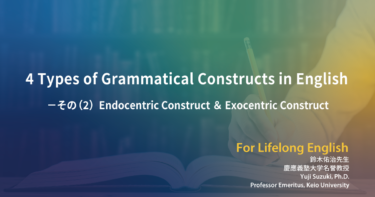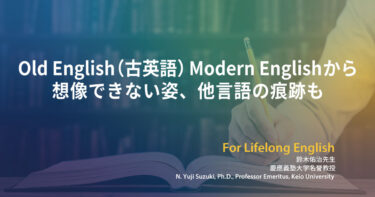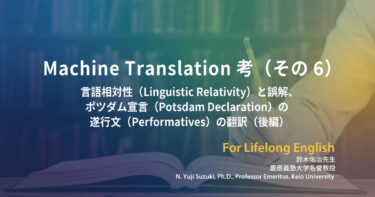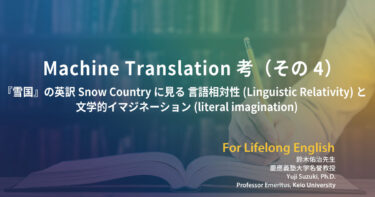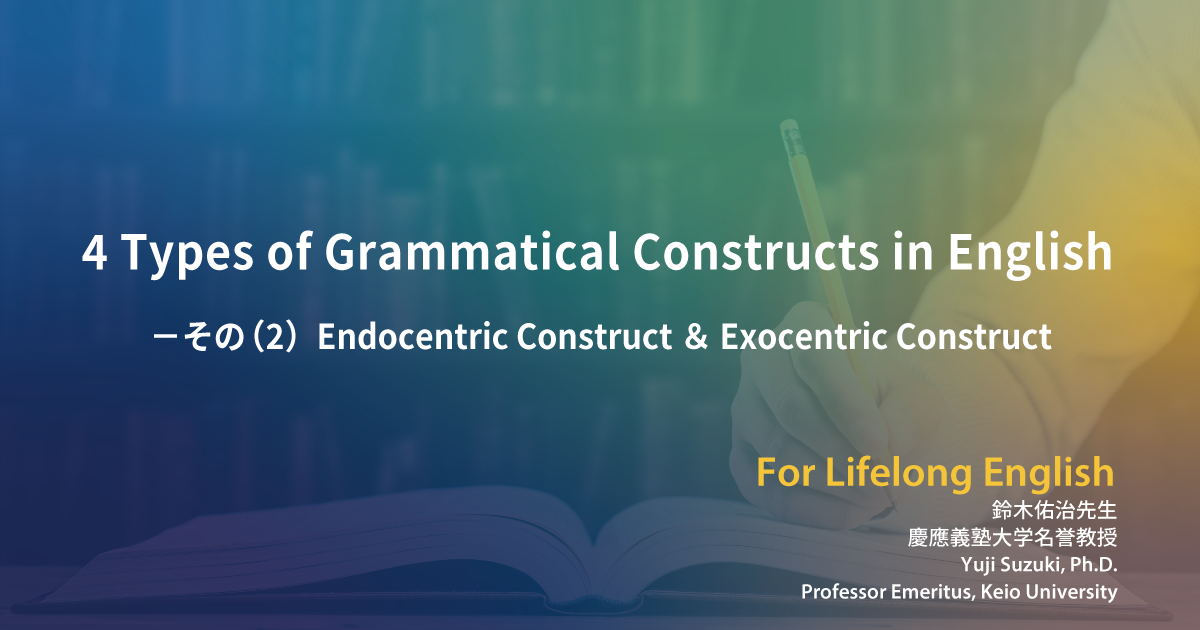
本コラム第137回「4 Types of Grammatical Constructs in English -その(1)Coordinate Construct」の続きです。Macdonald分析は、語を句などに組み合わせる統語構造として、coordinate construct(等位構造)、endocentric construct(内心構造)、exocentric construct(外心構造)、catenary construct(連鎖構造)の4つのconstructsを挙げました。その概要は以下の通りでした。
(1)Coordinate Construct(等位構造)は2つ以上の形態的に同等の項目を繋げ、同機能の構造を生む。式にすると以下の通りである。
![]()
X function classに属する項目を繋げ、その結果出来た項目はX function classに属する。例えば、“give”(verbal function)と“take”(verbal function)を繋げると、“give and take”(verbal function)が生まれる。(*1)よって、“*give and taking”(*2)のように、“give”はverbal functionを有し、“taking”が、動名詞形の場合はnominal functionを、現在分詞形の場合はadjectival functionを有しており、いずれも“and”というcoordinatorで繋げることはできない。
(2)Endocentric Construct(内心構造)は、例えば、“the meat on my table”ように、異なったクラスの項目で構成され、その内の一つの項目がhead(中心となる語、上例のイタリック部分)で、head以外の項目はheadを修飾し、出来上がった項目はheadと同じ機能を有す。

上例は、“the”(article冠詞)、“meat”(noun名詞)、“on”(preposition前置詞)、“my”(代名詞pronoun)、“table”(noun名詞)の4つのform classesに属する5項目(“meat”と“table”はnoun)で構成され、“meat”がhead、残りは“meat”を修飾し、結果、headのmeatと同じnominal functionを有す。
(3)Exocentric Construct(外心構造)は、“in the evening”のように異なるclassesの項目で構成され、Endocentric Constructのようなheadは存在せず、どの項目にも属さないfunction classの構造が生まれる。
![]()
上例の“in the evening”は、“in”(preposition前置詞)、“the”(article冠詞)、“evening”(noun名詞)から成り、出来上がった項目はadverbial functionを有す。
(4)Catenary Construct(連鎖構造)は、同じクラスの項目が鎖のように繋がり、その際に前の項目が次に来る項目の形態を規制する。出来上がった項目はこれらの項目と同じfunction classを有す。
![]()
時制、相、完了、態を表す動詞句の構造に見られる。例えば、“She will have been finishing it.”における下線部のそれぞれの項目は動詞であり、前の項目が次の項目の形態を限定しながら鎖状につながり、出来上がった構造はverbal functionを有す。(*3)
![]()
(Ross. Macdonald博士Morphology & Syntaxの筆者による授業ノートより)
第137回では、これら4種のconstructsの内、coordinate constructに焦点を当て、R. QuirkらのA Comprehensive Grammar of the English Language(1985, Longman)を参照に少し掘り下げてみました。今回は、endocentric constructとexocentric constructを取り上げます。
Macdonald先生の(English)Morphology and Syntaxの授業の推薦図書に、アメリカ構造主義言語学を代表するLeonard Bloomfield著Language(1933,1961. Holt, Rinehart and Winston, Inc.)がありました。(*4)Bloomfieldは、そのChapter 12“Syntax”(pp.184-206)Section 12.10(pp.194-195)で、syntactic construct(ion)を扱っています。(*5)以下はその要点です。Macdonald分析と比べながら目を通してください。
(1)全ての統語構造(syntactic construction)は、2つ以上のfree forms(独立形態)が結合して構成される句(a phrase)である。別名、the resultant phrase(終結句)と呼ぶ。
(2)終結句は、exocentric construction(外心的構造)とendocentric construction(内心的構造)の2種類に分類される。
(3)Exocentric constructionは、それを構成する項目のいずれとも異なるform-class(名詞、動詞、形容詞、副詞などの品詞)の句が終結する場合を指す。例えば、“John ran”のようなthe actor-action constructionは、それを構成する“John”(名詞)と“ran”(動詞)のいずれとも異なるform-classを持ち、exocentric constructionである。(*6)
(4)Endocentric constructionは、それを構成するいずれかの項目と同じform-classを有する句が終結する場合を指す。例えば、“poor John”という終結句は、構成する“poor”(形容詞)と“John”(名詞)中の後者と一致するので、endocentric constructionである。(*7)
(5)いかなる言語においてもexocentric constructionの種類は少ない。英語では、“John ran”のようなthe actor-action construction以外に、“beside John”“with me”“in the house”“by running away”のようなthe relation-axis construction(関係軸構造)がある。様々な統語的機能で使用され、例えば、“beside John”は“sit beside John”では動詞(sit)を修飾する副詞的用法として、“the boy beside John”では名詞(boy)を修飾する形容詞的用法として使用されている。(*8)
(6)英語のもう1種のexocentric constructionとしてsubordination construction(従属構造)があり、clause-subordinationとphrase-subordinationに細分される。前者は、“if John ran away”のように、“if”のようなa subordinating expression(従属表現)と“John ran away”のようなthe actor-action constructionで構成され、例えば、“What should we do if John ran away?”(筆者例)では、主節 “what should we do”にsubordinate clause(従属節)として組み込まれる。後者のphrase-subordinationは、“as I”とか“than John”のように、“as”と“than”のようなa subordinating expression(接続表現)と、“I”とか“John”のようなa substantive(名詞)で構成され、“as big as I”や“bigger than John”のような構造において修飾機能を持つ。
(7)このように、exocentric constructionでは、その終結句(節)の機能が、構成項目のいずれともform-classを異にする、これが主たる特徴である。しかし、それ以外の特徴として、“ran”のようなfinite verb(定型動詞)、“beside”のようなpreposition(前置詞)、“if”のようなsubordinating conjunction(接続詞)を伴うことが多い。
(8)Endocentric constructionは、coordinative(等位的)とsubordinative(従属的)の2種類に分類される。前者はserial(連続的)、後者はattributive(属性的)である。
(9)Coordinative endocentric constructionは、“boys and girls”のように、form-classを同じくする2個以上の項目が並列する構造である。通常、“and”のような“co-ordinator”(等位接続詞)を伴うが、“pens, pencils, blotters(were lying)”のように伴わないこともある。逆に、“both Bill and John”や“either Bill or John”のように、(慣用的表現を用いて)それぞれの項目に付すこともある。(*9)
(10)Subordinative endocentric constructionは、head(内心)と称される項目と、それを修飾するattribute(属性)と称する項目から成り、headと同じform-classの構造が終結する場合を指す。例えば、“poor John”では、headに当たる“John”に、attributeに当たる“poor”が組み込まれ、“John”と同じform-classの構造が終結する。
(11)Headとattributeは複合的である。例えば、“very fresh milk”では、“milk”がheadで“very fresh”がattributeであるが、そのattribute部分の“very fresh”では、“fresh”がheadで“very”がattributeである。他方、“this fresh milk”では、“this”がattributeで“fresh milk”がheadであるが、“fresh milk”では、“fresh”がattributeで、“milk”がheadである。こうして、attributeがheadに従属する形の階層構造をとり、“very fresh milk”においては、上から順に1.“milk”2.“fresh”3.“very”という階層が見られる。
(12)これら2種類のendocentric constructionにはcenterがある。例えば、“all this fresh milk” というsubordinative endocentric constructionでは、headの“milk”がcenterで、“all this fresh bread and sweet butter”というcoordinative endocentric constructionでは、“bread and butter”がcentersである。Endocentric constructionの終結句のform-classは“center”と同じである。いかなる言語でもconstructionsの大部分はendocentricで、よって、phrases(句)の大部分がcenterを有することになる。
(Bloomfield’s Language Chapter 12“Syntax”Sections 12.10 and Section 12.11, pp.194-196より。鈴木:訳、一部加筆)
このように、Bloomfieldは、Macdonald分析におけるcatenary constructを省く、coordinate construct、endocentric construct、exocentric constructの3つを取り上げています。更に、coordinate constructをendocentric constructの1種とし、endocentric construct(ions)にはcoordinative endocentric construct(ion)とsubordinative endocentric construct(ion)の2種類があると考えます。前者においては、2つ以上の同じform-classに属する項目が並び、同じform-classの句が終結する。後者においては、2つ以上の異なるform-classの項目が、その一部がheadとして、残りがattributeとして組み合わされ、headと同じform-classの句が終結する。Bloomfieldが考えるconstruct(ions)骨子は次のようになります。
[BloomfieldのConstruct(ions)の骨子]
(1)Exocentric Construct(ion)
(2)Endocentric Construct(ion)
1)Coordinative(serial)Endocentric Construct(ion)
2)Subordinative(attributive)Endocentric Construct(ion)
Macdonald分析と実質的には大差ありません。Bloomfieldのcoordinative endocentric construct(ion)は、Macdonald分析の coordinate constructの定義に一致し、subordinative endocentric construct(ion)は、Macdonald分析のendocentric constructに一致します。但し、Macdonald分析が、coordinate construct, endocentric construct, exocentric construct, catenary constructの4つのconstructsを並列してそれぞれ対等に扱っているのに対し、Bloomfield分析は、endocentric construct(ion)とexocentric construct(ion)の2つのみを同列に並べ、統語論におけるこれら2つのconstruct(ions)の役割を殊更に強調しているように思えます。
[Bloomfield分析とMacdonald分析のマッチング]
(1)Exocentric Construct(ion)=Macdonald’s Exocentric Construct
(2)Endocentric Construct(ion)
1)Coordinative Endocentric Construct(ion)=Macdonald’s Coordinate Construct
2)Subordinative Endocentric Construct(ion)=Macdonald’s Endocentric Construct
None ← Macdonald’s Catenary Construct
この分析上の違いは対象言語のスコープの違いにありそうです。Macdonald分析の対象言語は英語であるのに対し、(*10)Bloomfieldの対象言語は英語のみならずアジアやヨーロッパなどの多くの言語を含みます。(*11)これらの言語は異なる言語タイプに属し、これら2つのconstruct(ions)が共通に際立つと訴えているのでしょう。(*12)しかしながら、英語を対象にする場合、4つのconstructsを対等に並列して扱う方が以下の理由で理解しやすいかもしれません。
先ず、Bloomfield分析では全く言及されていないcatenary constructですが、時制(tense)、完了形や進行形などの相(aspect)、能動態や受動態などの態(voice)、助動詞(auxiliary)、本動詞に関わり、英語におけるその役割を考えると省けません。(*13)次に、coordinate constructですが、英語ではとても重要な構造で、QuirkらのA Comprehensive Grammar of the English Languageも、“Coordination”という章を設けて大々的に扱っており、endocentric constructのサブ構造として扱うことには違和感を覚えます。英語に関する限り、Macdonald分析のようにこれら4つのconstructsを同等に扱う方が至極自然に思えます。
関連して、Bloomfieldはendocentric construct(ions)について、いかなる言語でも、文法構造の大部分(“most of”)がendocentric construct(ions)であると述べていますが、(*14)endocentric construct(ions)にcoordinate construct(ions)を組み入れての言及であることを念頭に入れるべきです。Macdonald分析のように、coordinate constructとendocentric constructを分けていたら、この言及における「大部分の」を「多くの」程度に留めたでしょう。
更に、Bloomfieldはcoordinationをcoordinative endocentric construct(ions)として、subordinative endocentric construct(ions)と並列に組み入れることにより、2つのconstruct(ions)に共通する“center”という概念を導入しています。例えば、“all this fresh milk”というsubordinative endocentric constructionでは“milk”(“head”)がcenterです。また、“all this fresh bread and sweet butter”というcoordinative endocentric constructionにおいては、“bread and butter”がcenter(s)に当たると言います。そして、suboridinative endocentric construct(ion)においてもcoordinative endocentric construct(ion)においても、endocentric construct(ion)終結句は“center(s)”と同一機能を持つと述べます。
このように、Bloomfieldは、coordinate construct(ion)をendocentric construct(ion)に組み入れることにより、上述した通り、統語構造(constructions)の大部分はendocentric construct(ion)ということになり、よって、殆どの言語構造がcenterに当たる語を有し、例外は、exocentric construct(ion)に属する数少ない構造のみと述べています。(*15)一方、Macdonald分析では、(1)coordinate constructと(2)endocentric constructを分けており、centerという概念は不要であり全く言及されていません。要は、(1)coordinate constructと(2)endocentric constructを一緒にするか、分けて考えるかがポイントであるので、筆者なりにヒントを探してみました。
先ずは、“endocentric”「内心的」の語源を考えてみると、その接頭辞の“endo-(または“end-)”は、“within”、“inside”、“at home”を意味するギリシャ語に由来し、「内」とか「芯」を意味するので、字義的には、「核心の」という意味です。「核心」を比喩的に「心(こころ)」とか「頭(かしら)」と解釈すれば、headということになります。語源的には、endocentric construct(ion)は、Bloomfieldがいうところのsubordinative endocentric construct(ions)にはぴったり該当しますが、coordinative endocentric construct(ions)にまで広げて良いものか疑問が残ります。
構造上の複雑さも無視できません。後者のcoordinativeでは、“pens, pencils, blotters(were lying)”のように同等機能の項目なら幾つ並べても構いません。統語的にも意味的にもopenです。対して前者のsubordinativeでは、“this fresh milk”のように核(head)に向けてclosedな印象を受けます。(*16)節(clauses)の結合においては殊更そうです。例えば、“he has been accepted to a school”と“he doesn’t like it(the school)so much”という2つの独立節(independent clause)を繋げて1つの文にしてみます。
“He has been accepted to a school, but(he)doesn’t like it so much.”
(Coordinative)
“He has been accepted to a school(which)he doesn’t like so much.”
(Subordinative)
最初の文は、これら2つの独立節(clause)を等位接続詞(coordinator)“but”で連結した重文(compound sentence)です。2番目の文は、1つ目の節を主節とし、2つ目の節が従属節(dependent clause)として埋め込まれた(embedded)複文(complex sentence)です。(*17)即ち、主節中にある“to a school”の“a school”を関係詞節として修飾しています。ちなみに、主節の前置詞句“to a school”は“exocentric construction”で、従属節の終結句“a school which he doesn’t like so much”は、“a school”をheadとするendocentric construct(ion)です。
最初のcoordinativeの文と比較すると、subordinativeの文は構造上はるかに複雑です。前者は等位の独立節の並列であるのに対し、後者は1つの独立節を主節としてもう1つを従属節として埋め込むわけです。前者は、“and”、“but”、“or”などのcoordinatorsや“moreover”、“however”などのlinking wordsを間に挟むだけなのに、後者は、関係代名詞構文、分詞構文、不定詞構文などを使って圧縮しなければなりません。
加えて言語習得の順序もヒントになりそうです。英語の母語話者も非母語話者も、最初に“Dad bought me a doll,(and)I wanted it so bad(ly).”のようなcoordinative constructionを習得し、その後で“Dad bought me a doll I wanted so bad(ly).”のようなsubordinative constructionを習得するものと思います。言語習得上の難易度からも、これら2種類のconstruct(ions)をendocentric construct(ions)として一つにまとめるのには無理があり、特に英語に関する限り、Macdonald分析のように並列した方が良いかもしれません。
こうした違いはあるものの、Bloomfield分析はMacdonald分析を補完するかのような貴重な情報を提供しています。(*18) Languageの2ページ足らずの説明で十分とは言えませんが、例示が多い分、そこから敷衍して大まかながら一応の全体像を掴めます。上記の筆者要約中で提示された例示を辿りexocentric construct(ions)とendocentric construct(ions)に該当する構造を拾い纏めてみます。最初にexocentric construct(ions)です。上記要約の(5)と(6)から拾ってみましょう。
Exocentric construct(ions)
(a)The actor-action construction
“John ran”
(b)The relation-axis construction
“beside John”,“in the house”,“by running away”
(Macdonald例: “in the evening”)
(c)Clause subordination
“if John ran”
(d)Phrase subordination
“as I”,“than John”
更に、(7)では、endocentric construct(ion)の特徴として、(a)The actor-action constructionは定形動詞(finite verb)を、(b)the relation-axis constructionは前置詞(preposition)を、(c)clause subordinationには接続詞(conjunction)を含む、と述べています。
定形動詞(finite verb)を含むということであれば、“run”のようなaction verbを伴う the action-actor constructionだけではなく、状況を表すstate verbを伴ったthe state-patient construction(例:“he is smart”)や、過程を表すprocess verbを伴うthe process-patient construction(例:“he grows”)など、(*19)全ての定形動詞が含まれ、よって、自動詞(intransitive verb)や他動詞(transitive verb)、そしてそれらを使った5文型の全てが含まれるでしょう。また、定形動詞のみならず、不定詞(infinitive)など非定型動詞(non-finite verb)のconstruct(ion)は、例えば、“to run”のように、“to”と“run”いずれとも異なるform-classの終結句であるので、exocentric construct(ion)になるでしょう。
また、接続詞を伴う節ということでは、“if”で導かれる条件節(conditional clause)のみならず、“although”や“no matter how”で導かれる譲歩節(concessive clause)から、“when”、”where”、“how”、“why”など、時、場所、方法、理由に関する接続詞を伴う従属節も含まれます。そして、(d)で取り上げられた、“as”や“than”前置詞を伴う句は、両者とも、前置詞としても接続詞としての用法があり、(b)および(c)と関係します。(*20)
次に、endocentric construct(ions)についてです。記述した通り、subordinative endocentric construct(ions)に限定し、上記要約の(10)と(11)から拾ってみます。
(Subordinative)endocentric construct(ions)
“poor John”,“very fresh milk”,“this fresh milk”
(Macdonald例:“the meat on my table”)
これらは全て、headの語・句にattribute(属性)の語・句が従属するsubordinative construct(ions)従属構造です。上記のexocentric construct(ions)も従属構造ですが、Bloomfieldが、subordinative endocentric construct(ions)のsubordinativeをattributive(属性的)とも呼んでいるようにheadを修飾します。よって、関係代名詞句(例“a person who supported me”)、関係副詞句(例“places where I lived”)、不定詞の形容詞的用法(例“a place to visit”)、現在分詞や過去分詞、即ち、分詞の形容詞的用法(例“people standing there”)も、それぞれ、斜線部のheadを残りがattributeとしてその属性を描写するendocentric construct(ion)の例です。
しかしながら、ここで注意が必要です。同じ不定詞や分詞でも、独立的用法(例“To tell you the truth, I hate to go there”)や分詞を使った分詞構文(例“Having eaten too much, I wanted to skip the dinner”)は、これらの不定詞と分詞構文を言い換えれば、後者のように “since I had eaten too much”という主節を修飾する副詞節になり、exocentric construct(ion)ということになります。
また、exocentric construct(ions)とendocentric construct(ions)は互いに内包されることがあります。Bloomfieldの例“sit beside John”では、“beside John”はexocentric constructionですが、“sit beside John”では、“sit”をheadに“beside John”をattributeとする句が埋め込まれ、headである“sit”と同機能のendocentric constructionが終結します。同様に“the boy beside John”も“the boy”をheadにしたendocentric constructionです。逆に、“Mary sat beside John who used to go out with her”は、endocentric construct(ion)の“John who used to go out with her”が、exocentric construct(ion)の“sat beside John who used to go out with her”に組み込まれている例です。
確かに、exocentric construct(ions)とendocentric construct(ions)は英語の多くの構文を飲み込む構造であることは間違いありません。取り分け、endocentric construct(ions)は、Bloomfieldの「いかなる言語においてもconstructions(構造)の殆どがendocentricである」という言及通り、膨大で、読者の皆さんが英語の授業で習った多くの構文に関わっています。大学などの研究機関の図書館で、前回紹介したA Comprehensive Grammar of the English Language(1985. R. Quirk, et al. Pearson Education)を閲覧し、どれがexocentricで、どれがendocentricのconstruct(ion)に当たるかチェックしてみるのも良いでしょう。
(2020年2月24日記)
(*1)他の例:“ham”(nominal)+“egg”(nominal)=“ham and egg”(nominal);“up “(adverbial)+“down”(adverbial)=“up and down”(adverbial);“elegant”(adjectival)+“of the finest quality”(adjectival)=“elegant and of the finest quality”(adjectival)
(*2)言語学では非文法項目には、頭に*を付けるので本稿でもその慣行に従い、文頭に*は文法的ではない、非文という意味です。
(*3)“I want to learn to dance.”のような、動詞の目的語として不定詞がくる構造もcatenary constructの一つと述べておりました。
(*4)Leonard Bloomfield(1887-1949)はアメリカ構造主義言語学者。行動主義心理学(behaviorism)に依拠し、Languageはアメリカ構造主義言語学を代表します。1960年以降はNoam Chomskyの生成文法(generative grammar)にとって代わられますが、言語理論を探求する上でBloomfieldの分析は基盤知識として知っておく必要があります。将来言語学、英語学を学びたいと思っている読者には、Charles F. Hockett著A Course in Modern Linguistics(1958, The Macmillan Company), W. Nelson Francis著The Structure of American English(1958, The Rolland Press Company), Chomskyの恩師Zellig Harris著Structural Linguistics(1951.The University of Chicago Press)も推薦します。
 (Bloomfield, Hockett, Francis, Harrisの著書)
(Bloomfield, Hockett, Francis, Harrisの著書)

(”Constructions” Bloomfield’s Languageより)
(*5)Bloomfieldは“construction”という用語を使っていますが、本稿ではMacdonald分析に言及する場合には第137回で使用した“construct”を、Bloomfield分析に言及する場合には“construct(ion)”を適宜使用します。また、“construct”と“construct(ion)”は抽象名詞であるために複数形は取りませんが、両者とも普通名詞形として扱う場合は “constructs”、“construct(ions)”という表記を使用します。物質名詞や抽象名詞の普通名詞化についてはいずれ別稿で取り上げます。
(*6)第137回でも述べた通り(本稿の注1と注2)、formは言語形態、functionは言語機能です。また、form classは名詞とか形容詞などの品詞を指し、function classは名詞的機能とか形容詞的機能を指します。例えば、“boy”というformのform classは名詞ですが、“a boy friend”では“friend”を修飾する形容詞的機能を持ちます。Bloomfield分析においてもMacdonaldにおいてもconstruct(ion)の定義をする際に、これらの概念が緩く使われています。
(*7)Bloomfieldはこのようなconstructionを“the characteristic-substance construction”と呼びます。
(*8)要は、前者は副詞的機能、後者は形容詞的機能ということです。
(*9)Macdonald分析では、both…and…, either…or…, neither…nor..など、correlative coordinate constructとして扱っています。第137回では余白が限られ、割愛しました。
(*10)Languageの索引(Index)をチェックすると、English、Dutch、German、Danish、Estonian、Greek、Swedish、French、Italian、Spanish、Portuguese、Russian、Polish、Bohemian、Serbian、Semitic、Algonquian、Chinese、Japanese、Samoan、Tagalog、Hopiなど多くの言語を対象にしていることが分かります。
(*11)Macdonald先生の授業の正式名はEnglish Morphology and Syntaxでした。
(*12)世界の言語は、大きく分けて、analytic languagesとsynthetic languagesに分かれ、後者は更に、fusional languages、agglutinative languages、polysynthetic languagesなどに細分されます。英語のようなanalytic languageと日本語のようなagglutinative languageでは、語形成は言うに及ばず、統語構造にも相違があります。
(*13)別稿でcatenary constructの重要性を取り上げます。形態の数が限られるものの、時制(tense)、相(aspect)、法(mood)、態(voice)などに関連し、頻度的にはとても多く、無視できません。日本語話者の多くが英語学習で非常に苦労する項目の一つです。“People must have been being evacuated from the area.”の下線部がそれに当たります。英語話者の日本語学習者も苦労していました。筆者の博士論文は、この文中のmustに当たる法助動詞の意味論についてです。
(*14)“…most of the constructions in any language are endocentric..”(Language , P.195)
(*15)Bloomfieldは、“Exceptions are phrases of exocentric constructions.”と述べています。Language, P.196.より。
(*16)Wordsにはopen wordsとclosed wordsがあります。前者は一名詞、形容詞、動詞、副詞に属する語でその数は膨大で、造語や借入語の大部分が含まれます。後者は冠詞、代名詞、前置詞、助動詞など統語的機能性が強い語で、数は限られ、造語や借入語は稀です。これになぞらえ、ここではopenを開放的で、closedを限定的という意味で使ってみました。
(*17)ちなみに、1つの独立節から成る文(例:“He has been accepted to a school.”)を単文(simple sentence)と言い、複数の独立節と従属節から成る文(例:He has been accepted to a school, but he doesn’t like it since it’s so far away from his hometown.)を重複文(compound complex sentence)と言います。
(*18)(English)Morphology and Syntaxと称する序論コースの一コマ(90分)で、先生自身の研究のほんの一部に触れただけですから当然です。先生のseminarではその詳細に触れていたでしょうが、残念ながら、筆者は履修しませんでした。
(*19)格文法(case grammar)がこうした分析を行っています。関心ある読者は、Charles J. FilmoreのThe Case for Case(1968. Holt, Rhinehart and Winston)を読んでください。
(*20)関心がある読者は、QuirkらのA Comprehensive Grammar of the English Languageの“as”“than”参照してください。全国主要大学の図書館には本書が所蔵されていると思います。上記は掲載時の情報です。予めご了承ください。最新情報は関連のWebページよりご確認ください。

慶應義塾大学名誉教授
Yuji Suzuki, Ph.D.
Professor Emeritus, Keio University
上記は掲載時の情報です。予めご了承ください。最新情報は関連のWebページよりご確認ください。

英語圏の大学・機関だけでなく、世界160か国、11,500以上の大学・機関で、公式スコアとして留学や就活などに活用されています。コンピュータ上で受験し、スピーキングは回答音声をマイクを通して録音、ライティングはタイピングで回答します。

自宅受験TOEFL® Essentials™テスト
2021年から自宅受験型の新しいテストとしてリリースされました。約90分の試験時間、短い即答式タスクが特徴のアダプティブ方式の導入されています。公式スコアとして留学や就活などにご利用いただけます。

TOEFL ITP®テストプログラムは、学校・企業等でご実施いただける団体向けTOEFL®テストプログラムです。団体の都合に合わせて試験日、会場の設定を行うことができます。全国500以上の団体、約22万人以上の方々にご利用いただいています。


Criterion®(クライテリオン)を授業に導入することで、課題管理、採点、フィードバック、ピア学習を効率的に行うことを可能にします。


